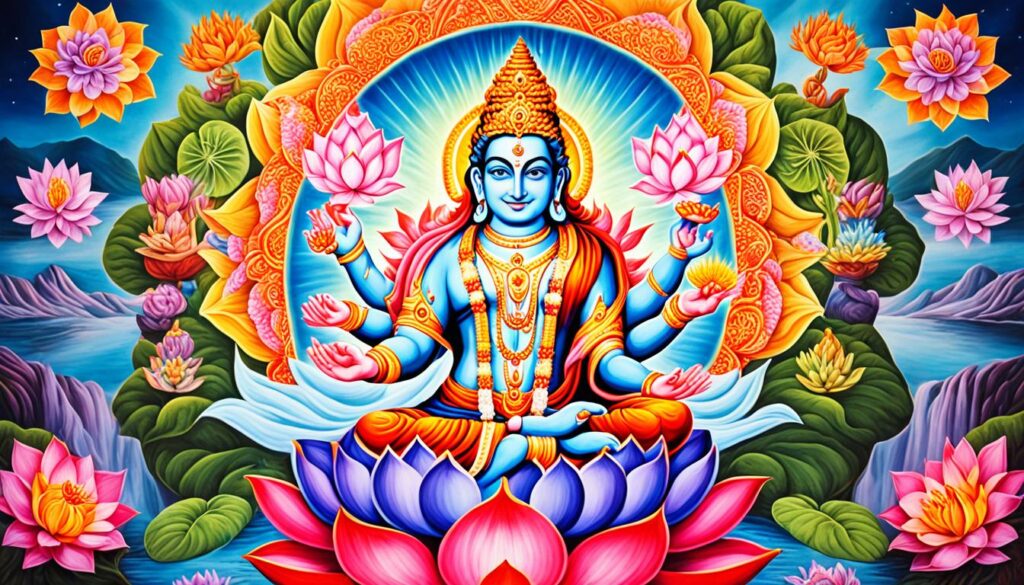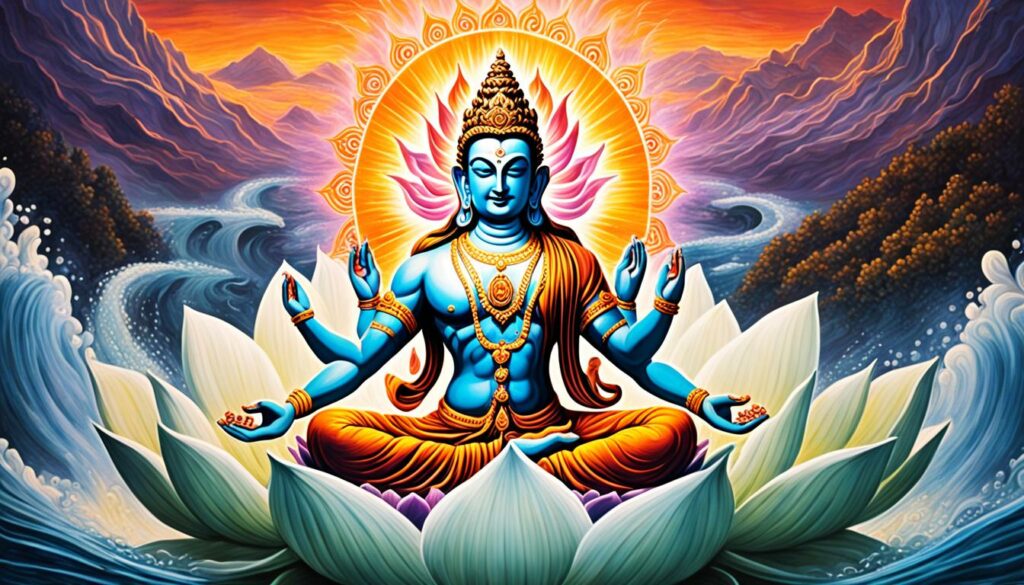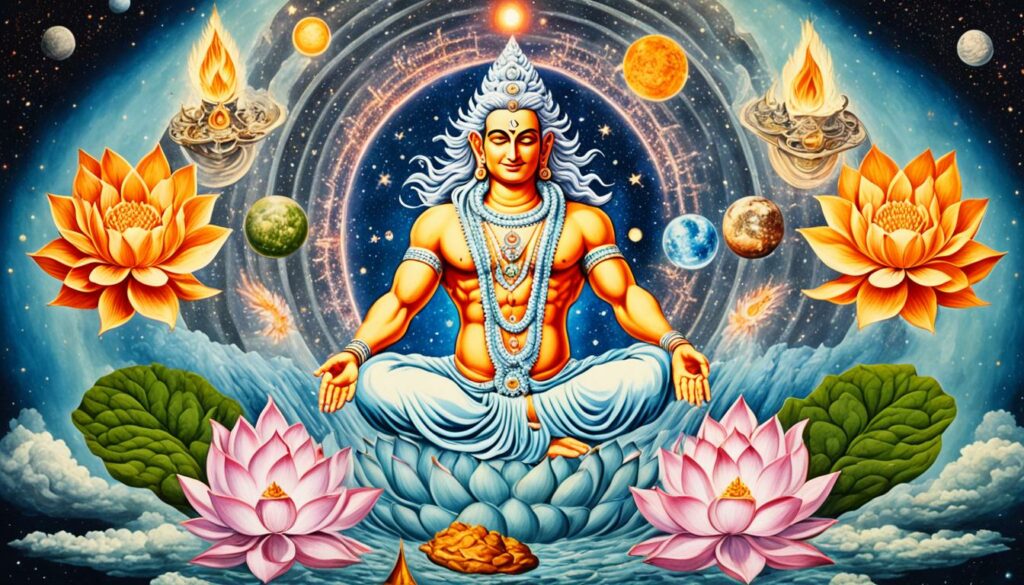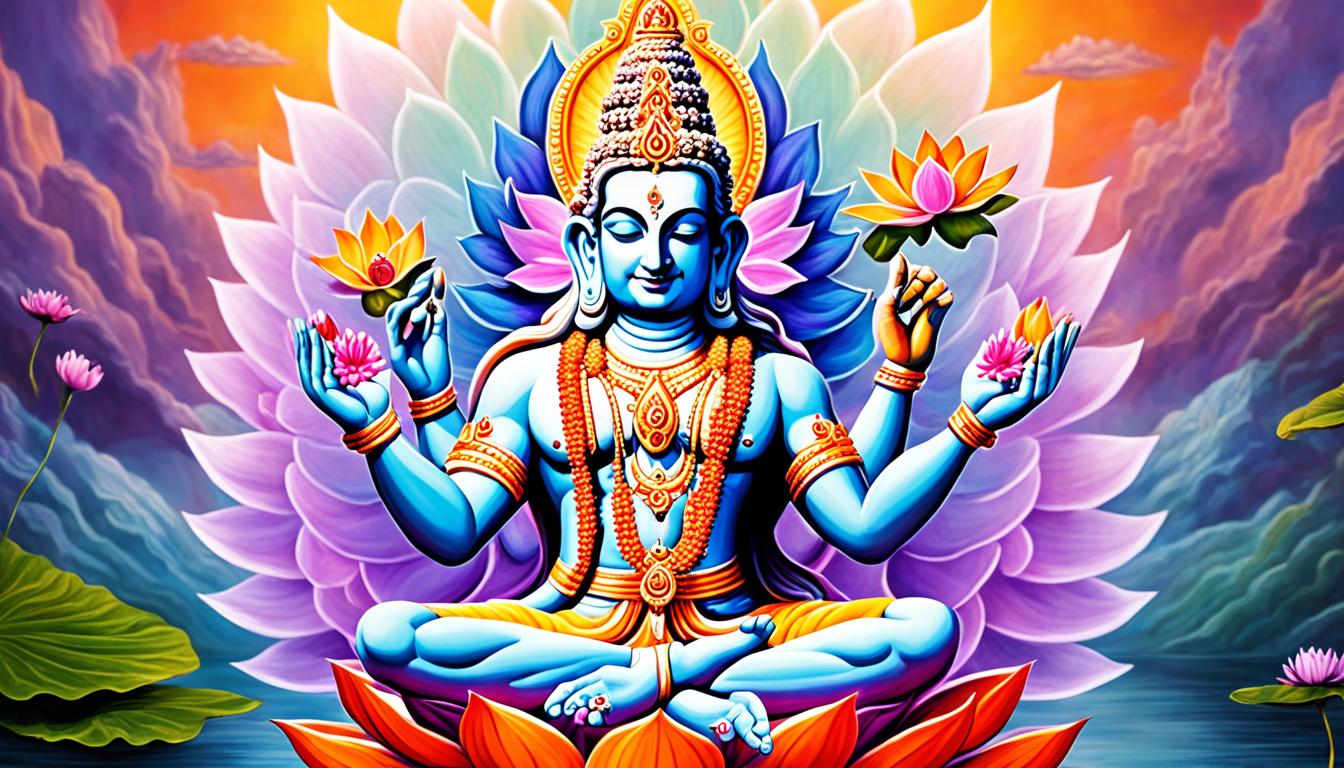Lord Brahma is a key figure in Hinduism, known as the Creator. He is part of the Trimurti, along with Vishnu and Shiva. He is linked to knowledge and the Vedas, which are sacred Hindu texts.
Once, Brahma was highly revered, especially during the Vedic period. But by the 7th century, his popularity dropped. Now, few temples are dedicated to him, yet his spirit lives on in Hindu myths and philosophy.
Who is Lord Brahma in Hinduism
Lord Brahma is a key figure in Hinduism, known as “the Creator.” He is part of the Trimurti, along with Vishnu and Shiva. He is often shown with four heads, each for a different Veda, the main texts of Hinduism.
Brahma lives in Satyaloka or Brahmaloka, where he rules the universe. He created gods, demons, ancestors, and humans. This shows his role in the start of life and the balance of good and evil.
Brahma worked with many consorts in myths. Sarasvati, his daughter, gave birth to the Vedas and other key Hindu ideas. Yet, his worship has greatly decreased over time, making him less popular today.
The story of Brahma is complex. He created Shatarupa, which led to negative views of him. He was punished by Shiva, losing a head and facing a curse. This led to few temples dedicated to him today.
Lord Brahma is a mix of creation and complex stories in Hinduism. He shows the beauty and challenges of his role in Hindu tradition.
The Role of Lord Brahma as the Creator God

Brahma is a key figure in Hindu mythology. He created the universe and all living things. He stands for the main ideas of Hindu thought.
He is known for creating twice: first, the original creation, and then the secondary creation. This shows the two sides of life. Brahma is also seen as the father of Dharma and wrote the Vedas, ancient Hindu texts.
Brahma has four heads, each looking in a different direction. This shows his all-knowing nature. He holds symbols like the Vedas and a mala, linking him to creation and knowledge.
His universe lasts for a day called Brahmakalpa, which is about four billion years. His cycles of making and breaking the world show the cycle of life. Even though he’s less worshipped now, his temple in Pushkar, Rajasthan, is still important.
Brahma’s story tells of creation and destruction. His death starts a new cycle. He helps us understand the universe and its rhythms.
Brahma Mythology: Origins and Legends

Brahma mythology tells stories of his beginnings and how he created the world. At the heart are tales of the “Golden Egg,” or Hiranyagarbha, which means the universe’s potential. These stories say Brahma came from this egg, creating everything we see.
Another story talks about Brahma’s birth. It shows his link to Vishnu through the lotus of Vishnu. This symbolizes the deep bond between gods in Hindu beliefs.
Creation from the Golden Egg (Hiranyagarbha)
The idea of Hiranyagarbha is key to understanding Brahma’s role. This golden egg is seen as the first thing in the universe. It took a long time for Brahma to come out, showing how long it took for creation to start.
When Brahma came out, he started creating the universe. This shows how important he is in the divine world.
Brahma’s Birth from the Lotus of Vishnu
Another legend tells how Brahma was born from a lotus in Vishnu’s navel. This story shows how the gods are connected. Brahma is seen as a key part of the divine order, not just a creator.
Many stories tell of his origins. They show Brahma as a key figure and a creator. He made not just gods and beings but also good and evil, showing balance in the universe.
Brahma’s Iconography and Symbols in Hindu Art
![]()
Brahma is a key figure in Hindu mythology. He has rich iconography that shows his role as the creator. Symbols in Hindu art represent his divine functions. They show the principles and concepts tied to his nature and influence.
The Four Heads and Four Arms of Brahma
The Brahma iconography shows four heads and four arms. Each part has deep symbolism. The four heads relate to the four Vedas: Ṛgveda, Yajurveda, Sāmaveda, and Atharvaveda. This shows his link to knowledge and wisdom.
Each face of Brahma symbolizes his wide wisdom. It lets him see the universe from different views. Brahma’s four arms hold important attributes for his role. One hand holds a mala (rosary), showing his connection to sacred texts. Another holds a waterpot, which means creation and time.
Significance of the Lotus and Other Symbols
The lotus is a key symbol in Brahma’s iconography. It stands for purity and spiritual perfection. Being on a lotus, Brahma comes from the dark waters to the light and divinity. The lotus means detachment and enlightenment, showing Brahma’s role in the universe.
Other symbols linked to Brahma include:
- Mala – represents the ongoing recitation of sacred texts.
- Waterpot – shows creation and the cycle of time.
- Book – stands for the knowledge and wisdom from the Vedas.
This iconography is not just art. It also holds deep spiritual and philosophical meanings. It shows the essence of Brahma as the creator god in Hindu tradition.
The Significance of Brahma in Hindu Philosophy

In Hindu philosophy, Brahma is more than just a creator. He is one of the three main gods, along with Vishnu and Shiva. Brahma shows us the deep themes of Hinduism. He connects the personal and impersonal sides of god.
Brahma is key to seeking enlightenment because he knows the divine. The Vedas, important Hindu texts, come from him. People who seek spiritual growth honor him by saying the Brahma Gayatri mantra.
Brahma’s role also shows how life is always changing. He has the three qualities of life: goodness, passion, and ignorance. This mix makes life diverse and teaches us about balance and harmony. Brahma’s work helps us seek knowledge for freedom (moksha).
- Brahma symbolizes the pursuit of knowledge and enlightenment.
- His four heads represent the four Vedas.
- He illustrates the interplay of the gunas in creation.
- Brahma promotes a deeper understanding of existence and reality.
Even though he’s not always in the spotlight, Brahma is crucial to Hindu philosophy. He encourages us to think deeply about life and reality. This search for knowledge is central to Hinduism.
Brahma Temples: Locations and Cultural Impact
The Brahma Temple in Pushkar, Rajasthan, is very important. It’s one of the few temples for Lord Brahma. This place is over 2000 years old and is a key spot for pilgrims.
It has a unique design with a red spire and marble pillars. People come to feel close to the god of creation. Legends say Brahma chose Pushkar himself, making it a sacred place.
In India, there are more Brahma temples. Each one adds to Hindu culture. For example, the Brahma Karmali Mandir in Goa and the Adi Brahma Temple in Himachal Pradesh show Brahma’s big impact.
These temples offer spiritual experiences and are full of historical beauty. They have daily rituals and festivals. This shows how important Brahma worship is.
Brahma temples also affect culture through festivals and art. The Kartik Purnima festival brings thousands to Pushkar Lake for rituals. This deepens the tradition in the community.
Lord Brahma’s image is found in Hindu art and literature. This keeps the story of creation alive. It also deepens spiritual beliefs in India and around the world.

